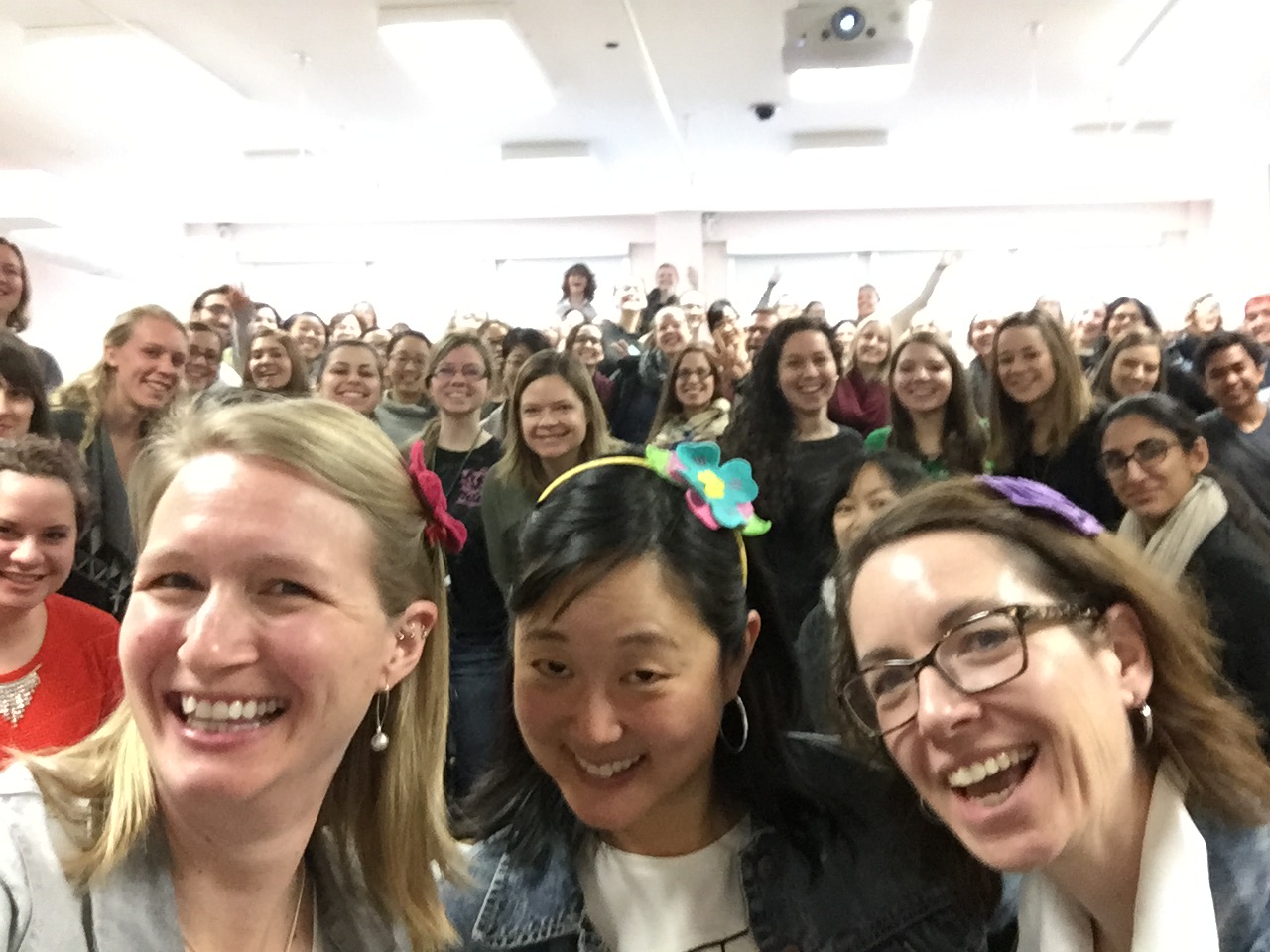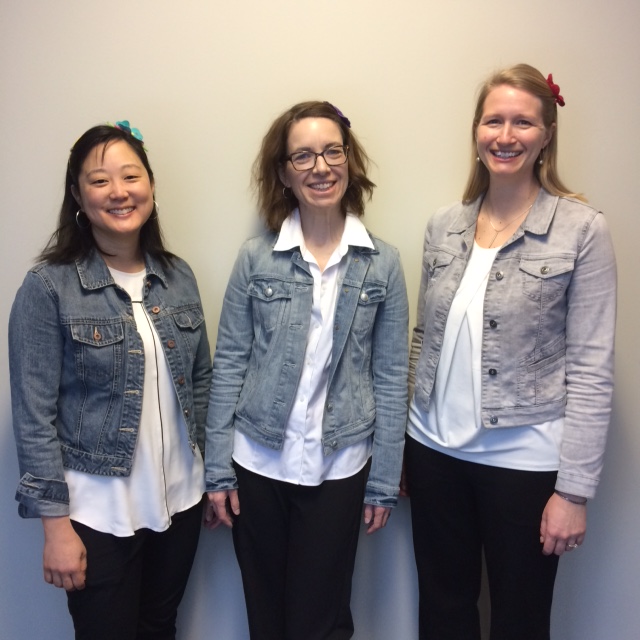
Andrea Ruelling, Esther Kim and Teresa Paslawski pose in front of first year SLP students.
(Edmonton) Historically, students in any program will attend lectures, seminars and labs of each course without much collaboration between classes. But innovative speech-language pathology (SLP) instructors at the University of Alberta's speech-language pathology program in the Department of Communication Sciences and Disorders at the Faculty of Rehabilitation Medicine may be turning that tradition on its head.
"In real practice, students must consider several aspects when dealing with a client," explains Esther Kim, instructor for the adult language disorders class. "As students are attending classes separately, there are times when they are focused on the material taught in one class and overlook other factors that might contribute to their client's condition."
First-year SLP students typically have eight months of lectures, labs and seminars before starting clinics in May. Because of the length of time students spend in classrooms, the need for practical learning within the eight months is important in preparing students for clinical placements. Students have designated integration periods twice per term.
"In our first integration block of winter term, we combined the adult language class with the motor speech class," says Kim. "We brought in an individual who has aphasia and apraxia of speech for students to get a sense of what it's like to deal with a client one-on-one and use their knowledge from both classes."
"We want our students to be the best speech-language pathologists, and to do this we needed to rethink how we structure our curriculum so that skills and knowledge from every course can be used. From then on, integrated education was born."
Students were broken into groups, who then selected one person from each group to assess one aspect of the client's functioning. All interactions were viewed live and videotaped so groups could use the information to come up with a treatment plan.
Having a live client experience gives SLP students a taste of what it would be like in the real world when dealing with a client. Despite the change in class structure, students are seeing the benefits of having integrated education.
"Integrated education allows us to make explicit connections between two courses that might otherwise have presented information in a compartmentalized fashion," explains Renzo Garcia, first-year SLP student. "These connections present themselves in various opportunities for us to apply shared concepts from the courses into practical and clinically relevant situations, working with our peers, standardized patients and even real clients."
"At times, it feels like we haven't had enough time to learn certain concepts," says Andrea Lau, first-year SLP student. "However, the professors are excellent at judging when we are adequately equipped and ready to apply our knowledge."
 The instructors played with the idea of integration & coordinated outfits and waited to see if the students noticed.
The instructors played with the idea of integration & coordinated outfits and waited to see if the students noticed.Teresa Paslawski, instructor for the motor speech disorder course, notices the change in how students approach clinical settings because their level of questioning appears to be more advanced at this stage in term. In addition, there is more independent discovery as students are observed and critiqued after demonstrating practical skills.
"In these classes, students are challenged with scenarios that are not straightforward, which encourages deeper thinking and problem solving" says Paslawski.
Integrated education is breaking down the barriers between different courses for students to adapt in various situations. Andrea Ruelling, clinical assistant professor, assists with the students' labs and classroom activities throughout the term and notes that these students are way ahead of the game due to these integration activities.
"Students receive lots of support at the beginning of integration blocks, with instructors slowly easing off to let the students develop their own abilities," says Ruelling.
Integration blocks have also built student confidence in their skills and knowledge of client assessments.
"It is fascinating-and sometimes surprising-to see how we are able to practically apply concepts that we have only very recently learned. To be able to learn from these experiences prior to starting clinic is one of the best takeaways," says Lau.
LuAnne McFarlane, academic coordinator of clinical education, says the bottom line is to provide the necessary support and learning opportunities for students to become successful SLPs.
"We want our students to be the best speech-language pathologists, and to do this we needed to rethink how we structure our curriculum so that skills and knowledge from every course can be used. From then on, integrated education was born."
___________________________________________________________
The Faculty of Rehabilitation Medicine at the University of Alberta
As the only free-standing faculty of rehabilitation medicine in North America, the Faculty of Rehabilitation Medicine's vision is to be at the forefront of knowledge generation and scholarship in rehabilitation. Through excellent teaching, research and service to the community, the Faculty is committed to enhancing quality of life, promoting participation and autonomy, and improving function for citizens in Alberta and beyond.
A research leader in musculoskeletal health, spinal cord injuries, common spinal disorders (back pain), seniors and dementia and speech-language disorders, the Faculty of Rehabilitation Medicine aims to inspire the realization of the full potential of individuals, families and communities. The three departments, Occupational Therapy (OT), Physical Therapy (PT) and Communication Sciences and Disorders (CSD) offer professional entry programs. The Faculty offers thesis-based MSc and PhD programs in Rehabilitation Science, attracting students from a variety of disciplines including OT, PT, SLP, psychology, physical education, medicine and engineering.